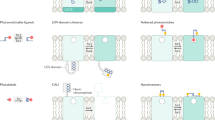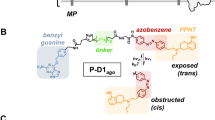Abstract
Advances in synthetic chemistry, structural biology, molecular modelling and molecular cloning have enabled the systematic functional manipulation of transmembrane proteins. By combining genetically manipulated proteins with light-sensitive ligands, innately ‘blind’ neurobiological receptors can be converted into photoreceptors, which allows them to be photoregulated with high spatiotemporal precision. Here, we present the optochemical control of neuronal nicotinic acetylcholine receptors (nAChRs) with photoswitchable tethered agonists and antagonists. Using structure-based design, we produced heteromeric α3β4 and α4β2 nAChRs that can be activated or inhibited with deep-violet light, but respond normally to acetylcholine in the dark. The generation of these engineered receptors should facilitate investigation of the physiological and pathological functions of neuronal nAChRs and open a general pathway to photosensitizing pentameric ligand-gated ion channels.
This is a preview of subscription content, access via your institution
Access options
Subscribe to this journal
Receive 12 print issues and online access
$259.00 per year
only $21.58 per issue
Buy this article
- Purchase on Springer Link
- Instant access to full article PDF
Prices may be subject to local taxes which are calculated during checkout






Similar content being viewed by others
References
Albuquerque, E. X., Pereira, E. F. R., Alkondon, M. & Rogers, S. W. Mammalian nicotinic acetylcholine receptors: from structure to function. Physiol. Rev. 89, 73–120 (2009).
Kew, J. N. C. & Davies, C. H. Ion Channels: From Structure To Function 2nd edn (Oxford Univ. Press, 2010).
Neher, E. & Sakmann, B. Single-channel currents recorded from membrane of denervated frog muscle fibres. Nature 260, 799–802 (1976).
Unwin, N. Refined structure of the nicotinic acetylcholine receptor at 4 Å resolution. J. Membr. Biol. 346, 967–989 (2005).
Nowak, M. W. et al. Nicotinic receptor binding site probed with unnatural amino acid incorporation in intact cells. Science 268, 439–442 (1995).
Noda, M. et al. Primary structure of alpha-subunit precursor of Torpedo californica acetylcholine receptor deduced from cDNA sequence. Nature 299, 793–797 (1982).
Noda, M. et al. Structural homology of Torpedo californica acetylcholine-receptor subunits. Nature 302, 528–532 (1983).
Noda, M. et al. Primary structures of beta-subunit and delta-subunit precursors of Torpedo californica acetylcholine-receptor deduced from cDNA sequences. Nature 301, 251–255 (1983).
Taly, A., Corringer, P-J., Guedin, D., Lestage, P. & Changeux, J-P. Nicotinic receptors: allosteric transitions and therapeutic targets in the nervous system. Nat. Rev. Drug Discov. 8, 733–750 (2009).
Kramer, R. H., Fortin, D. L. & Trauner, D. New photochemical tools for controlling neuronal activity. Curr. Opin. Neurobiol. 19, 544–552 (2009).
Fehrentz, T., Schönberger, M. & Trauner, D. Optochemical genetics. Angew. Chem. Int. Ed. http://dx.doi.org/10.1002/anie.201103236 (in the press).
Banghart, M., Borges, K., Isacoff, E., Trauner, D. & Kramer, R. H. Light-activated ion channels for remote control of neuronal firing. Nat. Neurosci. 7, 1381–1386 (2004).
Volgraf, M. et al. Allosteric control of an ionotropic glutamate receptor with an optical switch. Nat. Chem. Biol. 2, 47–52 (2006).
Fortin, D. L. et al. Optogenetic photochemical control of designer K+ channels in mammalian neurons. J. Neurophysiol. 106, 488–496 (2011).
Szobota, S. et al. Remote control of neuronal activity with a light-gated glutamate receptor. Neuron 54, 535–545 (2007).
Mourot, A. et al. Probing the reorganization of the nicotinic acetylcholine receptor during desensitization by time-resolved covalent labeling using [3H]AC5, a photoactivatable agonist. Mol. Pharmacol. 69, 452–461 (2006).
Hunt, R. & Renshaw, R. R. Some effects of derivatives of betaine amide and of choline ethers on the autonomic nervous system. J. Pharmacol. Exp. Ther. 35, 99–128 (1929).
Wong, K. C. & Long, J. P. Nicotinic and muscarinic activity of phenacyl and phenylalkyl trimethylamines. J. Pharmacol. Exp. Ther. 137, 70–75 (1962).
Gotti, C. et al. 4-Oxystilbene compounds are selective ligands for neuronal nicotinic Gk alpha-Bungarotoxin receptors. Br. J. Pharmacol. 124, 1197–1206 (1998).
Celie, P. H. N. et al. Nicotine and carbamylcholine binding to nicotinic acetylcholine receptors as studied in AChBP crystal structures. Neuron 41, 907–914 (2004).
Le Novère, N., Grutter, T. & Changeux, J-P. Models of the extracellular domain of the nicotinic receptors and of agonist- and Ca2+-binding sites. Proc. Natl Acad. Sci. USA 99, 3210–3215 (2002).
Brejc, K. et al. Crystal structure of an ACh-binding protein reveals the ligand-binding domain of nicotinic receptors. Nature 411, 269–276 (2001).
Hansen, S. B. et al. Structures of Aplysia AChBP complexes with nicotinic agonists and antagonists reveal distinctive binding interfaces and conformations. EMBO J. 24, 3635–3646 (2005).
Chavez-Noriega, L. E. et al. Pharmacological characterization of recombinant human neuronal nicotinic acetylcholine receptors ha2b2, ha2b4, ha3b2, ha3b4, ha4b2, ha4b4 and ha7 expressed in Xenopus oocytes. J. Pharmacol. Exp. Ther. 280, 346–356 (1997).
Gotti, C., Zoli, M. & Clementi, F. Brain nicotinic acetylcholine receptors: native subtypes and their relevance. Trends Pharmacol. Sci. 27, 482–491 (2006).
Nishimura, N. et al. Thermal cis-to-trans isomerization of substituted azobenzenes II. Substituent and solvent effects. Bull. Chem. Soc. Jpn 49, 1381–1387(1976).
Pozhidaeva, N., Cormier, M. E., Chaudhari, A. & Woolley, G. A. Reversible photocontrol of peptide helix content: adjusting thermal stability of the cis state. Bioconjug. Chem. 15, 1297–1303 (2004).
Bartels, E., Wassermann, N. H. & Erlanger, B. F. Photochromic activators of the acetylcholine receptor. Proc. Natl Acad. Sci. USA 68, 1820–1823 (1971).
Lester, H. A., Krouse, M. E., Nass, M. M., Wassermann, N. H. & Erlanger, B. F. A covalently bound photoisomerizable agonist: comparison with reversibly bound agonists at Electrophorus electroplaques. J. Gen. Physiol. 75, 207–232 (1980).
Barrantes, F. J. Modulation of acetylcholine receptor states by thiol modification. Biochemistry 19, 2957–2965 (1980).
Cox, R. N., Kawai, M., Karlin, A. & Brandt, P. W. Voltage fluctuations at the frog sartorius motor endplate produced by a covalently attached activator. J. Membr. Biol. 51, 145–159 (1979).
Chabala, L. D. & Lester, H. A. Activation of acetylcholine receptor channels by covalently bound agonists in cultured rat myoballs. J. Physiol. 379, 83–108 (1986).
Gorostiza, P. et al. Mechanisms of photoswitch conjugation and light activation of an ionotropic glutamate receptor. Proc. Natl Acad. Sci. USA 104, 10865–10870 (2007).
Sadovski, O., Beharry, A. A., Zhang, F. Z. & Woolley, G. A. Spectral tuning of azobenzene photoswitches for biological applications. Angew. Chem. Int. Ed. 48, 1484–1486 (2009).
Mourot, A. et al. Tuning photochromic ion channel blockers. ACS Chem. Neurosci. 2, 536–543 (2011).
Corringer, P-J. et al. Atomic structure and dynamics of pentameric ligand-gated ion channels: new insight from bacterial homologues. J. Physiol. 588, 565–572 (2010).
Bocquet, N. et al. A prokaryotic proton-gated ion channel from the nicotinic acetylcholine receptor family. Nature 445, 116–119 (2007).
Hilf, R. J. C. & Dutzler, R. X-ray structure of a prokaryotic pentameric ligand-gated ion channel. Nature 452, 375–379 (2008).
Law, R. J., Henchman, R. H. & McCammon, J. A. A gating mechanism proposed from a simulation of a human alpha7 nicotinic acetylcholine receptor. Proc. Natl Acad. Sci. USA 102, 6813–6818 (2005).
Sullivan, D. A. & Cohen, J. B. Mapping the agonist binding site of the nicotinic acetylcholine receptor. Orientation requirements for activation by covalent agonist. J. Biol. Chem. 275, 12651–12660 (2000).
Hibbs, R. E. & Gouaux, E. Principles of activation and permeation in an anion-selective Cys-loop receptor. Nature 474, 54–60 (2011).
Langmead, C. J., Watson, J. & Reavill, C. Muscarinic acetylcholine receptors as CNS drug targets. Pharmacol. Ther. 117, 232–243 (2008).
Dani, J. A. & Bertrand, D. Nicotinic acetylcholine receptors and nicotinic cholinergic mechanisms of the central nervous system. Annu. Rev. Pharmacol. Toxicol. 47, 699–729 (2007).
Aravanis, A. M. et al. An optical neural interface: in vivo control of rodent motor cortex with integrated fiberoptic and optogenetic technology. J. Neural Eng. 4, S143–S156 (2007).
Thomas, K. R. & Capecchi, M. R. Site-directed mutagenesis by gene targeting in mouse embryo-derived stem cells. Cell 51, 503–512 (1987).
Mourot, A., Bamberg, E. & Rettinger, J. Agonist- and competitive antagonist-induced movement of loop 5 on the alpha subunit of the neuronal alpha4beta4 nicotinic acetylcholine receptor. J. Neurochem. 105, 413–424 (2008).
Friesner, R. A. et al. Glide: a new approach for rapid, accurate docking and scoring. 1. Method and assessment of docking accuracy. J. Med. Chem. 47, 1739–1749 (2004).
Eldridge, M. D., Murray, C. W., Auton, T. R., Paolini, G. V. & Mee, R. P. Empirical scoring functions: I. The development of a fast empirical scoring function to estimate the binding affinity of ligands in receptor complexes. J. Comput. Aided Mol. Des. 11, 425–445 (1997).
Baxter, C. A., Murray, C. W., Clark, D. E., Westhead, D. R. & Eldridge, M. D. Flexible docking using Tabu search and an empirical estimate of binding affinity. Proteins: Struct., Funct., Bioinf. 33, 367–382 (1998).
Acknowledgements
Support for the work was provided by the Nanomedicine Development Center for the Optical Control of Biological Function PN2EY018241 (D.T., R.H.K.), The European Research Commission Advanced Grant (D.T.) and the Deutsche Forschungsgemeinschaft SFB 749 (D.T.).
Author information
Authors and Affiliations
Contributions
M.R.B., A.M., R.H.K. and D.T. designed the research. M.R.B. and J.Z.Y. synthesized the ligands. I.T., A.M. and B.G. performed the research and analysed the data. I.T., M.R.B. and D.T. co-wrote the paper.
Corresponding authors
Ethics declarations
Competing interests
The authors declare no competing financial interests.
Supplementary information
Supplementary information
Supplementary information (PDF 1249 kb)
Rights and permissions
About this article
Cite this article
Tochitsky, I., Banghart, M., Mourot, A. et al. Optochemical control of genetically engineered neuronal nicotinic acetylcholine receptors. Nature Chem 4, 105–111 (2012). https://doi.org/10.1038/nchem.1234
Received:
Accepted:
Published:
Issue Date:
DOI: https://doi.org/10.1038/nchem.1234
This article is cited by
-
The emergence of molecular systems neuroscience
Molecular Brain (2022)
-
Breaking photoswitch activation depth limit using ionising radiation stimuli adapted to clinical application
Nature Communications (2022)
-
Orthogonal Control of Neuronal Circuits and Behavior Using Photopharmacology
Journal of Molecular Neuroscience (2022)
-
Optical control of neuronal ion channels and receptors
Nature Reviews Neuroscience (2019)
-
A high-conductance chemo-optogenetic system based on the vertebrate channel Trpa1b
Scientific Reports (2017)



